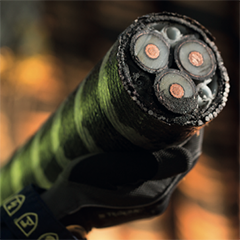Offshore power cables are the Achilles heel of the offshore wind industry. Without them, no energy is delivered to the main land. Unfortunately, these cables are often damaged by external reasons, most by collision with anchors or fishing nets. The Belgian start-up company, Marlinks, has a solution and PES wanted to know more.
Motivation for burying the cable
The most effective way of protecting these cables is by burying them in the sea bottom. However, the sea bottom is not static, but a moving landscape. Therefore, it is crucial for a cable owner to know what the depth of burial (DoB) of the power cable is. Especially the range between 0 (uncovered cable) and 1m DoB (minimum DoB for power cables in many areas) is critical. As the current monitoring techniques are expensive and require the mobilization of survey vessels, Marlinks has developed a technique to continuously calculate the burial depth based on the temperature of the cable, measured with a DTS (Distributed temperature sensing)
DTS measuring
The DTS technology offers the possibility of measuring the ambient temperature at which fibre glass is exposed, with some notable advantages compared to traditional temperature measurements. The temperature measurements take place along the entire length of the fibre glass, which can easily be several tens of kilometres, with a spatial resolution between 1m to 5m. By using fibreglass an enormous number of measuring points can thus be read where, traditional measurement techniques, cannot cope with number of measuring points, frequency of measurement or accuracy. As fibre optic cables are always present in a power cable and since the backscattered light is insensitive to extreme conditions, such as water, electric or magnetic fields, DTS is the ideal technique to measure the temperature in a power cable.
The measuring method itself is based on the dependency of the fibre optical properties, on its ambient temperature. Advanced algorithms enable accurate and reliable mapping, along the entire glass fibre. Figure 1 shows that a light source, in the form of a laser, sends a specific light pulse in the optical fibre. Due to the microscopic impurities in the glass, this light pulse is routinely scattered along its entire path and thus partially reflected as well.
The typical wavelength of the reflected light is shown in figure 2 which shows that the amplitude of the Anti-Raman frequency is dependent on temperature in contrast to the constant amplitude of the Raman frequency. Another temperature dependency can be observed with the Brillouin and Anti-Brillouin frequency, as these frequencies shift as a function of temperature but also of strain.
These phenomena are used to calculate the temperature on a single point of the cable. The location of the temperature measurements along the glass fibre is determined by multiplying the speed of the laser light in the glass fibre by the time between the laser pulse is sent and the reflection thereof called Optical Time Domain Reflectometry (OTDR). The accurate time measurements are translated into a spatial resolution of at least 1 measuring point per 5m. The low optical losses of the laser light in the glass fibre enable measuring over very long distances (tens of kilometres). This makes this technology very suitable for offshore applications.






























